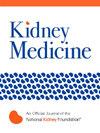Factors Influencing Recruitment, Retention, and Adherence Rates in Exercise Interventions in ESKD: A Scoping Review
IF 3.2
Q1 UROLOGY & NEPHROLOGY
引用次数: 0
Abstract
Rational & Objective
Majority of people with end-stage kidney disease (ESKD) are sedentary, which increases risk for decreased quality and quantity of life. Development of exercise programs with characteristics that address individual preferences may increase interest in participating and completing exercise programs. We evaluated which exercise intervention characteristics affect exercise program recruitment, adherence, and completion in people with ESKD receiving dialysis.
Study Design
Scoping review of randomized controlled trials (RCTs) with searching of Medline, Embase, Cochrane, and CINAHL databases through May 12, 2023.
Setting & Study Populations
Adults with ESKD receiving dialysis.
Selection Criteria
RCTs with exercise interventions of ≥12 weeks that included more than 10 people with ESKD receiving dialysis in each study arm.
Data Extraction
One individual extracted data and the second author checked for accuracy.
Analytical Approach
Data were synthesized qualitatively. Associations between intervention characteristics and recruitment, retention and adherence rates were assessed through one-way analysis of variance tests. Risk of bias was assessed using the Cochrane Risk of Bias 1.0 tool.
Results
Of 7,396 studies identified, 55 studies with 3,269 trial participants were included. The majority of participants were male (63.2%) and treated with hemodialysis (89.1%). Mean age was 56 ± 11.5 years. Average recruitment, retention and adherence rates were 77.4%, 81.2%, and 76.0%, respectively. Only 27% of studies reported adherence rates. No significant associations were found between intervention characteristics (ie, exercise type, duration, frequency, setting, and supervision) and recruitment, adherence, and retention rates.
Limitations
Data were limited by small sample size, suboptimal risk of bias, selective recruiting methods, and variability in definitions of adherence rates.
Conclusion
Average recruitment, retention, and adherence rates in exercise interventions for patients receiving dialysis were high although less than 1 in 4 studies reported adherence rates. These results call for standardized reporting of recruitment, retention, and adherence rates in exercise interventions.
Plain-Language Summary
Regular exercise for people with end-stage kidney disease (ESKD) can improve their quality of life. We sought to determine if there were certain characteristics of an exercise program such as exercise type, frequency, program length, and setting that were associated with enhanced recruitment, retention, and adherence to the program. From the 55 identified studies, average recruitment, retention, and adherence rates in exercise interventions were high irrespective of the program characteristics. However, it is unclear if our results are robust as there was a lack of formalized definitions for recruitment, retention, and adherence rates. Moreover, very few studies reported adherence rates. Therefore, we suggest that standardized definitions and reporting of these factors be required in exercise studies.
影响ESKD患者运动干预招募、保留和依从率的因素:一项范围综述。
理性与客观:大多数终末期肾病(ESKD)患者久坐不动,这增加了生活质量和数量下降的风险。针对个人喜好的锻炼计划的发展可能会增加参与和完成锻炼计划的兴趣。我们评估了哪些运动干预特征会影响接受透析的ESKD患者的运动计划招募、依从性和完成情况。研究设计:检索Medline、Embase、Cochrane和CINAHL数据库,纳入2023年5月12日的随机对照试验(RCTs)。环境和研究人群:接受透析的成人ESKD患者。选择标准:运动干预≥12周的随机对照试验,每个研究组包括10名以上接受透析治疗的ESKD患者。数据提取:一个人提取数据,第二作者检查准确性。分析方法:定性综合资料。通过单向方差分析检验评估干预特征与招募、保留和依从率之间的关系。使用Cochrane Risk of bias 1.0工具评估偏倚风险。结果:在7396项研究中,纳入了55项研究,3269名试验参与者。大多数参与者为男性(63.2%),接受血液透析治疗(89.1%)。平均年龄56±11.5岁。平均入职率、留任率和依从率分别为77.4%、81.2%和76.0%。只有27%的研究报告了依从率。干预特征(即运动类型、持续时间、频率、设置和监督)与招募、坚持和保留率之间没有发现显著关联。局限性:数据受到样本量小、次优偏倚风险、选择性招募方法和依从率定义的可变性的限制。结论:透析患者运动干预的平均招募率、保留率和坚持率很高,尽管只有不到1 / 4的研究报告了坚持率。这些结果要求对运动干预的招募、保留和依从率进行标准化报告。
本文章由计算机程序翻译,如有差异,请以英文原文为准。
求助全文
约1分钟内获得全文
求助全文

 求助内容:
求助内容: 应助结果提醒方式:
应助结果提醒方式:


